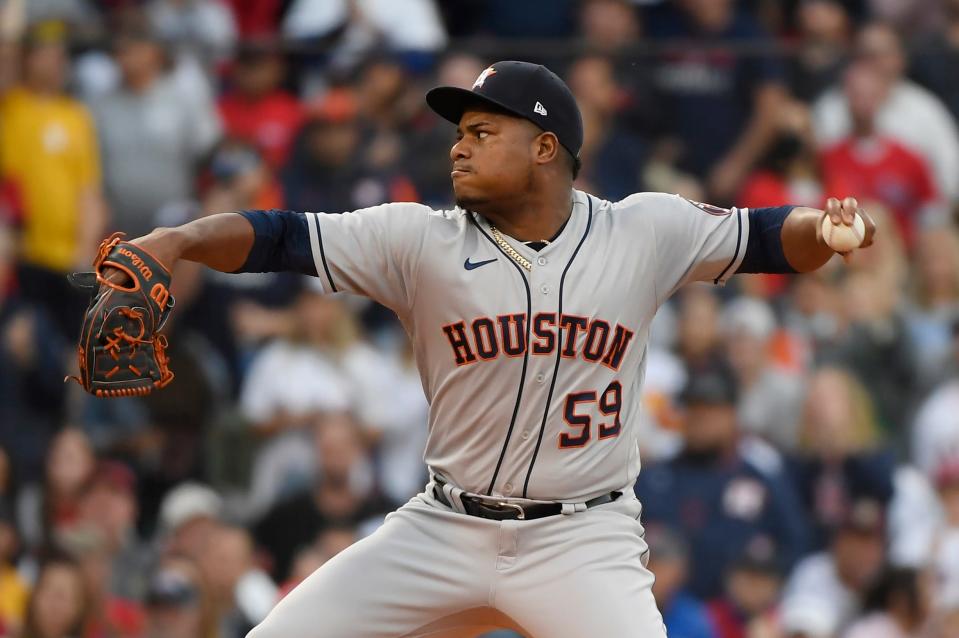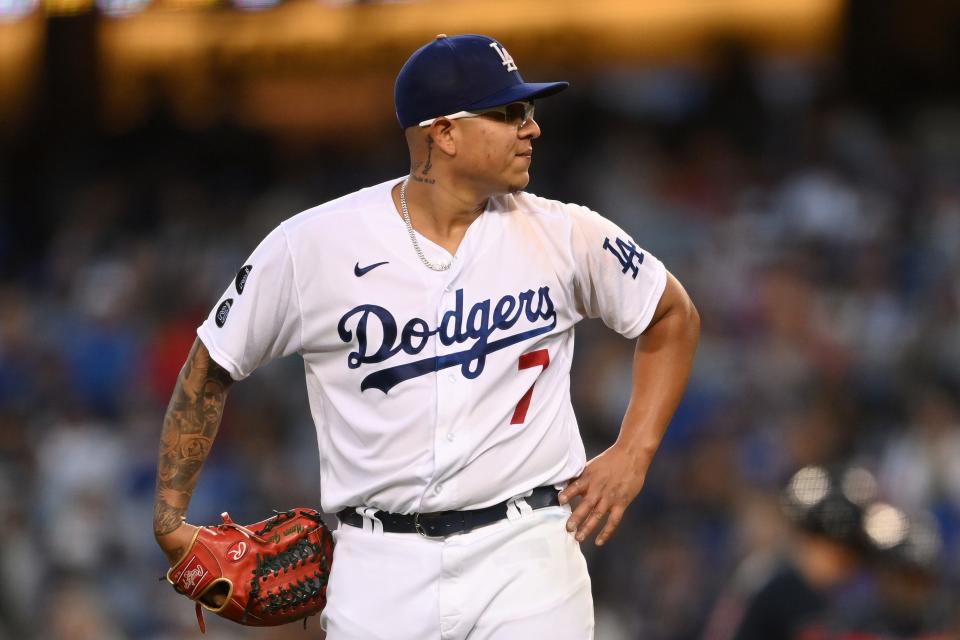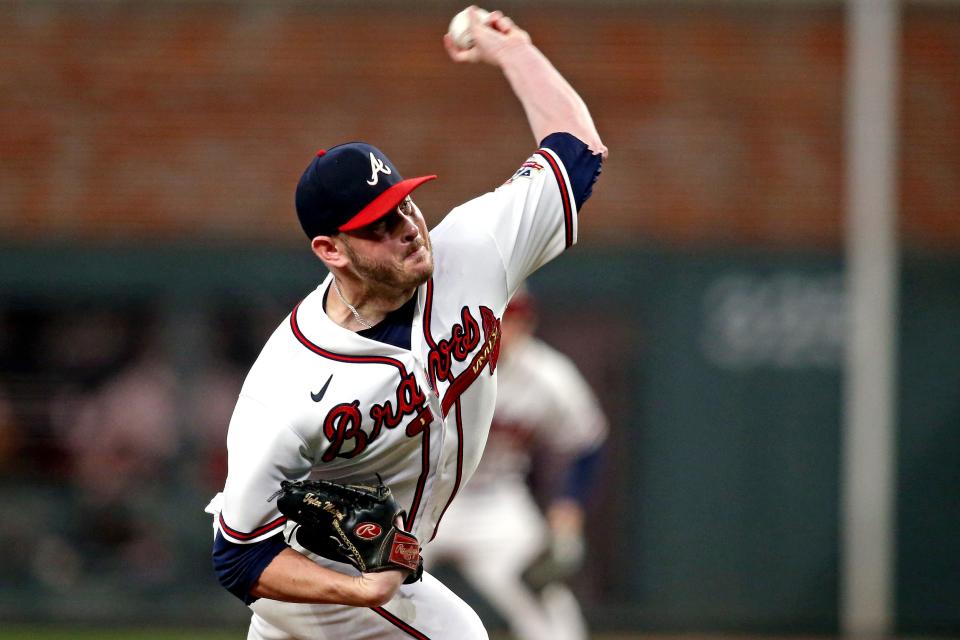Short starts, long games: MLB playoffs amplify game's pitching crisis. Where will it go from here?
- Oops!Something went wrong.Please try again later.
- Oops!Something went wrong.Please try again later.
- Oops!Something went wrong.Please try again later.
- Oops!Something went wrong.Please try again later.
- Oops!Something went wrong.Please try again later.
HOUSTON — Major League Baseball’s 2021 postseason has provided no shortage of thrills, from startling walk-off hits to feats of individual strength and gallant performances from mound to batter’s box.
It’s also provided the following:
An average game time of 3 hours, 40 minutes, an entire half-hour longer than the slowest-ever 3:10 benchmark set this season.
An average starting pitcher lasting just 4.1 innings, a figure that drops to 3.67 innings in the American League, what with managers even freer to ponder matchups with pitchers not required to hit.
The defending World Series champion Los Angeles Dodgers ousted after winning 112 total games, quite possibly due to overthinking regarding their pitching staff.
Sure, home runs put fans in the seats, but the game can’t start until the pitcher throws the ball – and the manner in which they throw it (and the length they’re allowed to do so) exerts significant control over the sport.
And if anything, this postseason of “openers” and “favorable pockets” has only illuminated where the game may be headed. In a sense, we’ve seen baseball’s past, present and future play out over these 30 highly scrutinized games.
The past?
FREDDIE FREEMAN AT LOSS FOR WORDS: 'Means the world to me'
'MIND-BLOWING': Tyler Matzek makes name for himself in leading Braves to World Series
In a sport steeped in nostalgia, the good ol’ days are always revered, and thus hearts young and old were warmed by San Francisco Giants right-hander Logan Webb powering through seven and 7 2/3 innings in his two National League Division Series starts against the Dodgers, or Houston Astros lefty Framber Valdez shutting down the powerful Boston Red Sox for eight innings of a crucial American League Championship Series Game 5.

Take a picture: No other starters touched the eighth inning this postseason.
The present?
It is an often messy, highly analytical and ultimately volatile period in which hitters hellbent on home runs and fearless of strikeouts engage in a nine-inning tango with pitchers determined to avoid their “nitro zone,” often at the risk of the game-extending and manager-maddening bases on balls. Time will tell if this is a permanent normal or a fractious period caught between eras.
The future?
Perhaps we glimpsed it through the lens of the AL and NL champion Astros and Braves, whose biggest heroes may have been not a starter or a closer but rather multi-inning power arms like Cristian Javier and Tyler Matzek, the latter striking out 17 in 10 1/3 innings, including four in a two-inning burst to send the Dodgers home.
You’d think it’d be harder for clubs to find nine powerful, reliable arms rather than four dependable starters. Yet the game's current conditions have created a pitching crisis in the major leagues, leaving the industry to ponder the next twist in an evolution borne of shifts in pitcher development, analytics and cost control.
“It’s interesting to be involved in this decade, this era of baseball,” said Astros reliever Kendall Graveman, who can tell his grandkids he once threw 186 innings in a single season, yet should command life-changing money this winter after a 56-inning, 61-strikeout 2021. “You listen to GMs across the league and some teams may be going to a three-inning, three-inning, three-inning kind of deal.
“As a starter, I felt like I was under the category of trying to get 200 innings, so I was pitching to a little more contact and try to let my defense play a little baseball. Now, as a reliever, knowing what the data says when you create swing-and-miss, it’s a lot better than a guy putting a soft ground ball in play and being a hit.”
Or better yet, spending hours in a pitching lab designing a pitch, studying opposing hitters’ tendencies like the SAT and then sneaking that pitch into a speck of the strike zone, rendering said hitter helpless.
“Because nothing,” said Red Sox reliever Adam Ottavino, “can go wrong on a called strike.”
Wanted: Four capable starters
The focus on the punchout is laudable, and the thirst of front-office game-planners for them insatiable. Winning, after all, is why everyone is here.
“So it doesn't matter how appealing it is or what it is,” said Dodgers manager Dave Roberts. “The goal is to prevent runs on the pitching side.”
Certainly, appeal may not matter winning a zero-sum game. But a $10 billion industry is nothing without fans, and baseball’s struggles at the box office, its desire to snag younger fans and the existential crisis of cord-cutting all are well-documented.
Four-hour games and a largely faceless parade of relievers seem like no way to counter those trends. And decision-makers would prefer it not be that way.
“Hey, man, we all want the starter to go seven. You know, we would love that,” said Red Sox manager Alex Cora. “It's a lot easier for a manager and for the pitching coach and for everybody else to navigate a game that way.”
Cora’s playoff teams of 2018 and 2021 neatly illustrate that four top-flight starters are nearly impossible to beat in October, while a piecemeal approach leaves much more to chance.
The ’18 Red Sox won 108 regular season games and come playoff time, unleashed Chris Sale, Nathan Eovaldi, Rick Porcello, David Price and Eduardo Rodriguez on the postseason field. All are starters yet every one of them appeared out of the bullpen, too, in high-leverage situations.
And the Red Sox went 11-3 to capture the World Series championship.
A year later, the Washington Nationals ripped a page from that playbook, essentially using just six pitchers to survive a wild card game and roll all the way through an upset of the Houston Astros in the World Series. The bedrock was starting pitchers Stephen Strasburg, Max Scherzer and Patrick Corbin – who all appeared in relief – along with No. 4 man Anibal Sanchez.
Yet as the years go by, and the paucity of competent starting pitching is exacerbated, finding a reliable fourth starter has proven elusive.
After winning the 2020 World Series despite an inconsistent No. 4 option, the Dodgers left nothing to chance, signing Trevor Bauer to a $102 million contract to give them seven worthy starters.
And then Dustin May needed Tommy John surgery. Tony Gonsolin got hurt. Bauer has been on administrative leave in July and faces allegations of sexual assault. Clayton Kershaw suffered a forearm injury in September that knocked him out of the playoffs.
Despite acquiring Scherzer on July 30, the Dodgers still had only three reliable starters entering October. He gave them just enough to survive the wild-card game on a walk-off homer, but come Game 5, was asked to close out the Giants in the ninth.
That game was started not by Urías but rather Corey Knebel, who began a relay of six pitchers to win a 2-1 game. Urías was third out of the chute, pitched four effective innings and threw 59 pitches.

Ostensibly, the modernized plan worked. Yet it came with questions — might Urías have lasted longer than four innings had he simply started the game? — and costs.
With no fourth starter, the Dodgers lost a “bullpen game” in Game 1 of the NLCS. Scherzer started Game 2 two days after his NLDS Game 5 save but was spent in the fifth inning; his arm remained "dead," and he'd miss the rest of the NLCS.
Desperate not to fall in a 2-0 NLCS hole, Urías was deployed in relief in Game 2, blowing a save and throwing 14 pitches in the 6-5 loss. Three days later, Urías was rocked in his regularly scheduled Game 4 start, and with Scherzer unavailable in Game 6, the Dodgers were eliminated when Buehler gave up all four runs in four innings, on three days’ rest.
“As a whole,” Scherzer said, “they looked at us to have four starters going in the postseason, but we don't. And so we're just trying to navigate this as best as possible.”
Yet how can the Dodgers, with a payroll nearing $300 million and arguably the wisest front office in the land, struggle to produce a playoff-worthy quartet?
The answer is partially steeped in two decades of starting pitching degradation.
'We crush their development'
And it’s happened so quickly. Graveman, 30, debuted with Toronto in 2014, just seven years but many eras ago. He joined a Blue Jays team that saw Mark Buehrle, 35, top the 200-inning mark for the 14th time and 39-year-old knuckleballer R.A. Dickey throw 215 2/3 innings.
“I’m sitting here like, 'It’s doable, it’s possible,'” he said of a 200-inning campaign. “And then you had Marcus Stroman and Aaron Sanchez looking up to them and saying, ‘If they can get 200, I can get 200.”
Yet the game was about to change.
From 2014 to 2015, the major leagues saw a significant increase — 14% to 19% — in the percentage of pitchers whose average fastball measures at least 95 mph, according to StatCast data. The trend toward straight fire came one decade into a massive revamp in batter behavior, pitcher usage and outcomes.
From 2003 – a nebulous marker based on the start of the drug-testing era and the publishing of the seminal "Moneyball" – through 2021, pitching got a lot more difficult:
Pitches per plate appearance are up 5% from 3.74 in 2003 to 3.91 this year, peaking at 3.97 in 2020.
Pitchers used per game rose 21% from 2003 (3.67) to 4.43 this year (4.41 in 2019, the most recent pre-pandemic season).
Batting average dropped 8% from .264 in ’03 to .244 this year, but home runs rose 30%, from 1.07 per team game to a high of 1.39 in 2019, a widely-acknowledged juiced-ball season. That mark was 1.22 this year, a 14% rise from 2003.
Strikeouts are up 37% from 2003 (6.34) to 2021 (8.68), peaking at 8.81 in 2019.
The demise of the 200-inning starter followed – 44 in 2003, down to four in 2021, a year innings limits were tracked heavily after just a 60-game 2020. In pre-pandemic 2019, there were still just 15 200-inning guys, a 66% decrease from ’03.
The statistical case has been oft-stated: Starters are significantly penalized the third time they face a batting order. In 2021, it meant a .238 batting average and .708 OPS the first time through, and .262/.779 the third time around. Hey, why not turn it over to a cadre of shaggy-haired, mustachioed dogs throwing 97 mph, even if they carry the “failed starter” tag?
“When you’re taking your starter out, you’re not sacrificing much anymore in terms of stuff,” said Ottavino. “In fact, you’re probably bringing in a guy with more power in his game.”
Still, from the dugout to the C-suite, everyone can agree a seven-inning horse provides a far more predictive and sustainable environment than a bottomless trough of relievers. So why can’t teams grow them anymore?
“One of the problems we have is we crush their development by not letting them extend themselves, and we’re very careful with them,” said Astros pitching coach Brent Strom, who at 73 remains one of the most innovative pitching gurus in the sport.
“But it’s symptomatic of life: We used to play in sandboxes and not wear seatbelts and eat bugs, and now the whole thing is very, very careful. You adapt to some of that.”
It’s probably unsurprising that six of the game’s eight biggest innings-eaters in 2021 were signed in 2012 or earlier. And one name blinks like a red light on this list: Adam Wainwright, the 40-year-old Cardinals ace who tossed 206 1/3 innings and carried a 3.05 ERA, all with a fastball that averages 89.3 mph.
In an era when velocity is king, how?
A sampling of peers who watch him closely reveal myriad reasons: A curveball that remains one of the top five pitches in the game, thrown at a velocity (73.5 mph) hitters rarely see. An ability to get called strikes on his two-seam fastball by first throwing it intentionally out of the zone. Smarts. And a longstanding relationship with catcher Yadier Molina.
In any era, there aren’t a ton of Wainwrights. And coming off a decade where starters in the minor leagues were increasingly “piggybacked” and watched more mindfully than ever, and often summoned to the majors first as a high-impact reliever, they simply aren’t conditioned to last that long.
Throw in the ever-elusive manager’s trust – which now must be earned from the front office, too – and a generation of hitters putting a premium on patience followed by unbridled aggression, and the runway to sustained innings-eating is narrowed.
“Guys are brought up now to be a little more max effort, and required intensity is higher,” said Ottavino. “It’s not necessarily anybody’s fault, but if you think you’re going to go out there on some sort of cruising speed for four or five innings, you’re probably putting yourself, in this day and age, in danger. Everybody can homer. There’s a lot more quick-strike offense.
“I just think the overall difficulty of it is higher than people realized or used to be.”
Strom said in discussing the three-times-around maxim with Sandy Koufax, the Hall of Fame lefty stressed how he’d refuse to pitch Willie Mays, say, the same way the third time through. That’s great.
Yet there is only one Koufax – zero, at the moment, active – and besides, Koufax’s opponents didn’t have a bevy of printouts noting pitchers’ red and blue zones more reliably than election maps of Alabama and California.
And there’s only so many unicorns like Boston’s Eovaldi, who has five pitches he throws at least 10% of the time and can add or subtract 20 mph from pitch to pitch.
Tough to defend as a hitter.
“You just have to become really, really complete as a pitcher to become a guy who can go deep in games,” said Ottavino. “When you’re getting ready for a pitcher, there’s so little mystery that hitters’ approaches have become a little more sophisticated. If you don’t have something that can kind of yang to that yin, then you might be in trouble.”
So, quantity over quality, then?
Maybe not.
'Deeper they go, easier it is'
Relief pitchers are notoriously volatile from a performance standpoint, and in this max-effort era, a physical one, too.
Nobody does it better than the Tampa Bay Rays, who pioneered the “opener” strategy and, along with Strom’s Astros, excel at maximizing performance by identifying a pitcher’s best characteristics and urging them to lean heavily on those strengths.
They came within two wins of a World Series championship in 2020 thanks in large part to a group of nine relief pitchers that complemented veteran starters Charlie Morton, Blake Snell and Tyler Glasnow.
In 2021, they bowed out to Boston in a four-game ALDS and the losses of Morton (free agent), Snell (trade) and Glasnow (elbow injury) were huge factors.
Yet of the nine relievers used in the ALDS, just two – Josh Fleming and Pete Fairbanks – returned from their 2020 World Series bullpen.
Can a unit that turns over 78% of its personnel from year to year consistently be relied upon?
“The importance is still on the starters,” said Dusty Baker, the Astros’ 72-year-old manager who returns to the World Series for the first time since 2002. “The deeper they go, the easier it is on your bullpen. Just because things have changed, that doesn't make it right.
“I mean, you see how many relievers go on the IL. Are there enough relievers to go around? So I see it returning. I don't know if it will go all the way back to eight, nine innings.”
Indeed, there are anomalies, even among teams viewed largely as “smart.”

The NL Central champion Milwaukee Brewers have opened up an ace-growing compound, gradually nudging along young arms Brandon Woodruff, 2021 ERA champion Corbin Burnes and Freddy Peralta into All-Star starting pitchers, with Aaron Ashby, 23, possibly next in line. The Brewers (3.13) trailed only the Dodgers in starter ERA and they ranked fifth in the majors in starter innings pitched.
Heck, they even managed to win a playoff game – the opener of their NLDS to the Braves – in exactly three hours.
That anomalous achievement may become more frequent if MLB, as many current players expect, adopts a pitch clock. Early returns from minor-league experiments have been encouraging, though it would require significant adjustments at the major league level.
Most notably, a 15-second gap between pitches would penalize max-velocity arms who benefit from recovery time between pitches.
That would require a significant course correction from front offices. They can always seek counsel from the players and managers who have seen their game evolve at warp speed.
“You have to adapt,” said Baker, “or else you don't have a job.”
This article originally appeared on USA TODAY: World Series: MLB playoffs highlight pitching crisis. What's next?

